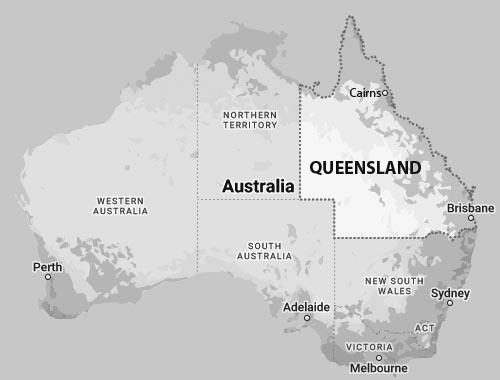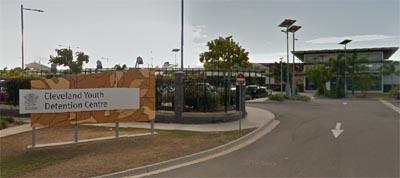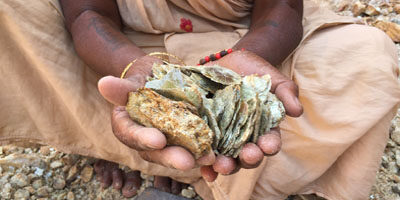Editor’s note: In September 2023 Queensland suspended its Human Rights Act, not for the first time, to allow locking up more children. The government now allows under-18s – including children as young as 10 – to be detained indefinitely in police “watch houses” – local jails – while awaiting process. This can take weeks.
Queensland had the highest number of children in detention of any Australian state, almost 300 minors in detention. 63 percent of them are Indigenous, despite Indigenous people make up only 4.6 percent of Queensland’s population. Source: Al Jazeera
On a clammy morning two years ago in Cairns, Far North Queensland, a First Nations boy’s battles with the police and the justice system came to an awful turning point. It was Valentine’s Day in the tropics, the wet season.
The night before, Saturday, 13 February 2021, the 13-year-old boy, ‘Gabriel’, and his 14- year-old non-Indigenous friend, Bradley Smith, broke into a house in suburban Cairns, stole car keys, a wallet and a mobile phone. They drove away in the owner’s Toyota Yaris.
Cairns is a city of 150,000, the gateway to the Barrier Reef and the World Heritage Wet Tropics. It also has one of the highest crime rates in Queensland and is home to a large Indigenous population.
Along the way Gabriel and Smith picked up friends, dropped others off, and in the early hours of 14 February went for a high speed drive through the suburbs. Gabriel, behind the wheel, had taken methamphetamine and smoked cannabis. Smith sat in the back seat with the others.
Gabriel live streamed the drive on his Instagram page. The wipers were running. It was raining and the roads were slippery. At one stage the car accelerated from 0 to 82kph in 11 seconds.

When Gabriel faced court on Wednesday, 8 March 2023, Crown Prosecutor Christopher Cook made a nearly four-hour submission detailing his 144 prior criminal convictions, starting when he was 11 or 12. They included serious assaults, numerous entering premises and stealing, robberies, burglaries, and unlawful use of motor vehicles. He had a lengthy traffic record without even having a driver’s licence.
Cook showed the court footage of police monitoring Gabriel’s live feed that night on a mobile phone at the station. They were watching and knew him and his social media account by name. They sent out a vehicle.
The public gallery in court on that Wednesday was tense and police were present in numbers. Smith’s sisters and Gabriel’s family were already making angry comments and as the first footage was shown a fight broke out in the public gallery. Women were screaming and police rushed in to separate them. From the dock, Gabriel called out ‘Mum, mum’.
Chief Justice Helen Bowskill shouted – bellowed – above the noise for order before she adjourned the court. When it reconvened she demanded decorum and warned everyone she expected ‘dignified behaviour from all, most of all for the young person being sentenced’.
Gabriel asked to be removed from the dock before further footage of the night was shown, and he was taken out.
Police dashcam footage showed the police car in pursuit accelerating to 130kph at times trying to catch Gabriel’s car, but the Yaris remained a set of lights in the distance. Further footage showed police laying ‘stingers’ across the road to deflate the stolen vehicle’s tyres, but ultimately they were not used.
At 1.13am on Valentine’s Day, the Yaris burned a red light in suburban Manoora and overtook another car at an intersection. Gabriel lost control, the Yaris swerved, the rear passenger door slammed into a tree and the party was over.
The next footage shown was from body cams as police officers approached the wrecked vehicle. One child appeared to have been thrown on the grass, another looked like they were trapped in the car. Gabriel was unconscious at the wheel.
As police approached he regained consciousness and tried to restart the car, then threw himself at the door like a trapped animal. Officers told him to calm down. They opened the driver’s door, he burst out and they took him to the ground and handcuffed him. He swore at them and told them he was not the driver.
The toll that Valentine’s Day was Bradley Smith, 14, who was sitting in the middle of the back seat, dead, and another child with chest and spinal injuries that rendered her a quadriplegic. Two more children required extensive hospital treatment and one lost their spleen. None of them was over 14, none wore seatbelts. Four of them, including Gabriel, were allegedly on bail.
Prosecutor Cook told the court the community was at risk every time Gabriel was out of custody and ‘a constant theme’ had been his offending in the face of court orders. His criminal history is breathtaking and that’s no compliment,’ Cook said. ‘The Cairns community has been under siege. He is a recidivist high-risk offender.’
At the time of the crash Gabriel was travelling over the speed limit by at least 60kph, high on ice and cannabis.
Cook told the court Gabriel had been involved in 77 incidents including fights, security threats and possessing prohibited articles since he had been in custody. Cook concluded his almost four-hour monologue with a startling conclusion. Gabriel was a danger to the community and could not be rehabilitated.
This crash was arguably a catalyst for events that unfolded in Queensland over the next couple of years. The Murdoch press – spearheaded by the Cairns Post and the Courier Mail – relentlessly stoked public outrage, and in early 2023 the Palaszczuk government drove tough new legislation into force, aimed at ‘recidivist’ youth offenders.
The ‘Strengthening Community Safety’ Bill tightened bail conditions, made breach of bail a crime for children, and created an ‘aggravating factor’ for alleged car thieves who posted footage of their offending on social media.
In what also looked like a direct response to Gabriel’s spree, unlawful use of a motor vehicle where a child is a passenger was added to the list of new offences. Queensland youth justice advocates and legal bodies raised their hackles. The Greens argued the legislation was ‘disgraceful’ and said Labor ‘lacked imagination’ to deal with the causes of youth crime. Even Bob Katter’s Australian Party expressed doubts the laws could work.
Meanwhile, behind closed prison doors in Queensland children like Gabriel are being locked in solitary confinement in increasing numbers, for ever-lengthening periods of time.
Confinement
On 21 February this year Judge Tracey Fantin released a scathing judgement over the case of a 14-year-old First Nations boy who had been held in lengthy periods of solitary in north Queensland. He was 13 when he and others hit a trolley collector at a Cairns shopping centre with sticks, knocked him to the ground and took his mobile phone. They demanded money from him. He said he needed his phone to withdraw cash and they returned it. He went in to the shopping centre and alerted security.
The boy was arrested on 3 August 2022. In her sentencing remarks Fantin wrote that his parents were not able to look after him properly because they were drug users. ‘You were removed from their care when you were just a baby,’ she wrote. ‘Their drug use affected you before you were even born, and you have suffered the consequences of that as part of your physical make-up. Those consequences (…) you have had some diagnoses because of your mother’s drug and alcohol use while pregnant (Foetal Alcohol Syndrome) and others that have affected you (Attention Deficit Hyperactivity Disorder).’
For 78 of the 87 days he was held, including at Cleveland Youth Detention Centre, he was confined in his cell for 20 hours or more each day. ‘For 10 of those 87 days, you have been confined in your cell for 24 hours per day,’ she wrote. ‘That is, you have effectively been held in solitary confinement.’

Fantin described the incarceration as ‘completely contrary to the regime of the Youth Justice Act and the Youth Justice principles. Particularly principle 18, that a child should be detained in custody for an offence, whether on arrest, remand or sentence, only as a last resort and for the least time that is justified in the circumstances.’
‘It is unsurprising that if you lock up a child for such lengthy periods of time with no stimulation other than access to a television, a child is likely to respond by behaving poorly. And that their behaviour over time is likely to deteriorate, including by causing damage to property, and that there is an increased risk of assault on staff or others.’
In another case heard in the Cairns District Court in February a First Nations boy had been held in the Mareeba Watch house. Judge Dean Morzone spoke of the child’s 60 days in custody, 45 of which had been in ‘isolation’. He described the treatment as ‘torturous’.
In March 2023 the Department of Children, Youth Justice and Multicultural Affairs responded to questions – without answering them – about children being held in solitary confinement in Queensland. ‘Youth detention centres are complex and difficult environments, and practices used in the centres are designed to ensure the safety of staff and young people at all time,’ its statement said.
‘A separation’ (departmental euphemism for solitary confinement) ‘is an event that requires young people to be secured (separated) in their rooms and can occur in response to a number of situations, including emergencies and other types of incidents, as well as health, safety and security requirements, and staffing shortages. Separations are used as a last resort. At all times during a separation, young people have access to visits and professional support services, phone calls, education material, meal routines and recreational activities.’
In April another Queensland judge, Alexander Horneman-Wren, called on government ministers to investigate the treatment of a 13-year-old boy who had been held in solitary while on remand at the Cleveland Youth Detention Centre in Townsville. He noted the boy had been subjected to the ‘harshest of conditions’ during 11 of his 32 days in custody, and had been confined for 23 hours and 59 minutes a day – just 60 seconds a day out of his cell.
An eternal present
Sentencing Gabriel on 10 March, Justice Bowskill outlined the difficulties he had faced growing up. His cognitive impairments were remarkably similar to those of the boy Judge Fantin sentenced on 21 February. He had been diagnosed with FASD, general anxiety disorder, ADHD and depression. In her summing up she said he was at high risk of suicide. He had difficulty in seeing more than five minutes ahead, had ‘pervasive brain dysfunction’, and he ‘simply lived in an eternal present’. He had engaged only sporadically with the Forensic Child and Youth Mental Health Service.
‘You have been in trouble with the law so many times, the community is frightened about what you will do next,’ she told him. Restorative justice was mentioned, that Gabriel was prepared to apologise to Smith’s sisters, but Justice Bowskill acknowledged that the process would not be suitable in this case. She rejected the prosecution’s submission that Gabriel was beyond rehabilitation.
‘I have to protect the community from the risk that you might do something bad like that again. I also have to think about you, as a young person who has had a difficult family life, without people to look after you and show you the right way to do things. Because you have a problem that affects the way that your brain works, there are things you find very difficult in life – including thinking about your actions and consequences – and you will need help with that.’
Justice Bowskill sentenced him to seven years imprisonment. He will have to serve 70 per cent, or nearly five years, before he will be eligible for parole.
In her sentencing remarks over the boy involved in the shopping trolley incident, Judge Fantin wrote, ‘As other judicial officers in other jurisdictions in this country have observed, if you treat a child like an animal, it is unsurprising that they may behave like an animal.’
In the last hour of April this year a three-car collision near Maryborough in Queensland took the lives of three women and severely injured a fourth. Police allege a stolen Mercedes crashed into the back of a Holden, sending it into the path of another oncoming vehicle on Saltwater Creek Rd, Maryborough, at 11pm on Sunday, 30 April.
Kelsie Davies, 17, nurse Sheree Robertson, 52, and pastor Michale Chandler, 29, were killed. Kayla Behrens, 23, who was in the car with Davies and Chandler, was taken to hospital in a critical condition.
Police alleged that the Mercedes was stolen from a house in Maryborough. The alleged driver was a 13-year-old boy from Bundaberg.
Andrew McKenna
Andrew McKenna has been a journalist for more than 30 years, published in Australia and the USA, and with theatre works presented in Australia and on national radio.



